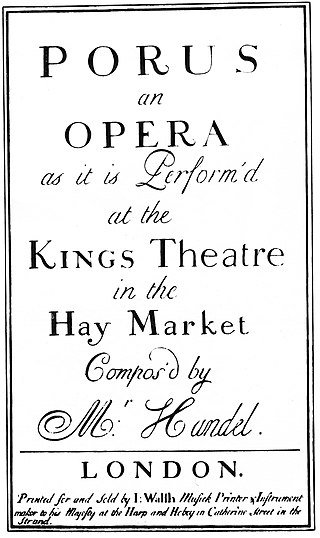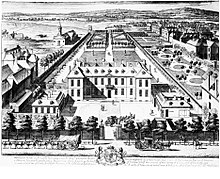
Amadís de Gaula is an Iberian landmark work among the Spanish and Portuguese chivalric romances which were in vogue in the 16th century, although its first version, much revised before printing, was written at the onset of the 14th century in an uncertain place of the Iberian Peninsula.

Flavio, re de' Longobardi is an opera seria in three acts by George Frideric Handel. The Italian-language libretto was by Nicola Francesco Haym, after Matteo Noris's Flavio Cuniberto. It was Handel's fourth full-length opera for the Royal Academy of Music. Handel had originally entitled the opera after the character of Emilia in the opera.

Teseo is an opera seria with music by George Frideric Handel, the only Handel opera that is in five acts. The Italian-language libretto was by Nicola Francesco Haym, after Philippe Quinault's Thésée. It was Handel's third London opera, intended to follow the success of Rinaldo after the unpopular Il pastor fido.

Scipione, also called Publio Cornelio Scipione, is an opera seria in three acts, with music composed by George Frideric Handel for the Royal Academy of Music in 1726. The librettist was Paolo Antonio Rolli. Handel composed Scipione whilst in the middle of writing Alessandro. It is based on the life of the Roman general Scipio Africanus. Its slow march is the regimental march of the Grenadier Guards and is known for being played at London Metropolitan Police passing out ceremonies.

Rodrigo is an opera in three acts composed by George Frideric Handel. Its original title was Vincer se stesso è la maggior vittoria. The opera is based on the historical figure of Rodrigo, the last Visigothic king of Spain. The libretto was based on Francesco Silvani's II duello d'Amore e di Vendetta. Dating from 1707, it was Handel's first opera written for performance in Italy, and the first performance took place in Florence late in 1707.

Sosarme, re di Media is an opera by George Frideric Handel written in 1732 for the King's Theatre in the Haymarket, London, where it ran for 12 performances. The text was based on an earlier libretto by Antonio Salvi, Dionisio, Re di Portogallo, and adapted by an unknown writer. The original setting of Portugal was changed to Sardis in Lydia.

Il pastor fido is an opera seria in three acts by George Frideric Handel. It was set to a libretto by Giacomo Rossi based on the famed and widely familiar pastoral poem of the 'Il pastor fido' by Giovanni Battista Guarini. It had its first performance on 22 November 1712 at the Queen's Theatre in the Haymarket, London.

Poro, re dell'Indie is an opera seria in three acts by George Frideric Handel. The Italian-language libretto was adapted from Alessandro nell'Indie by Metastasio, and based on Alexander the Great's encounter with Porus in 326 BC. The libretto had already been set to music by Leonardo Vinci in 1729 and was used as the text for more than sixty operas throughout the 18th century.

Floridante is an opera seria in three acts by George Frideric Handel. The Italian-language libretto was by Paolo Antonio Rolli after Francesco Silvani's libretto for Marc'Antonio Ziani dramma per musica La costanza in trionfo of 1696.

Imeneo is an opera seria in three acts by George Frideric Handel. The Italian-language libretto was adapted from Silvio Stampiglia's Imeneo. Handel had begun composition in September 1738, but did not complete the score until 1740. The opera received its first performance at the Lincoln's Inn Fields in London on 22 November 1740, and received another performance on 13 December. Handel then revised the score, and this revised version received concert performances in Dublin, on 24 and 31 March 1742.
Amadis usually refers to the romance novel Amadis de Gaula.

Ezio is an opera seria by George Frideric Handel to a libretto by Metastasio. Metastasio's libretto was partly inspired by Jean Racine's play Britannicus. The same libretto had already been set by many other composers, first of all Nicola Porpora who managed to preempt the official Rome premiere of Pietro Auletta's setting for 26 December 1728 with his own version for Venice on 20 November, a month earlier. The libretto continued to be set and reset for another 50 years, including two versions of Ezio by Gluck. Handel's Ezio is considered one of the purest examples of opera seria with its absence of vocal ensembles.
Giacomo Rossi was an Italian poet, translator and librettist who settled in London early in the 18th century and wrote librettos for George Frideric Handel, between 1710 and 1729.
Isabella Girardeau was an Italian operatic soprano who flourished in London, England from 1709 to 1712. Commonly referred to by the opera going public in London as "La Isabella", she is best remembered today for creating the role of Almirena in the momentous premiere of George Frideric Handel's Rinaldo on 24 February 1711 at the Queen's Theatre in the Haymarket in which she introduced the famous aria "Lascia ch'io pianga". She had succeeded Joanna Maria Lindelheim, "The Baroness", as one of the leading sopranos at that theatre. She is said to have had a bitter rivalry with the Queen's other prima donna, the soprano Elisabetta Pilotti-Schiavonetti.
Elisabetta Pilotti-Schiavonetti was an Italian operatic soprano who was associated with the House of Hanover. She was one of the leading prima donnas at the Queen's Theatre in the Haymarket from 1710 to 1717. She is best remembered today for creating roles in at least four operas by George Frideric Handel, possibly five. Three of the roles that Handel wrote specifically for her were sorceresses, and the demands of those roles indicate that she possessed an exceptional voice capable of both dramatic power and technical agility. She is said to have had a bitter rivalry with the Queen's other leading soprano, Isabella Girardeau.

Aure soavi e liete is a Baroque dramatic secular cantata in the key of E-flat major composed by George Frideric Handel in 1707 while he was serving as Kapellmeister to the Ruspoli family in Rome. The author of the text is unknown. Other catalogues of Handel's music have referred to the work as HG l,12. The cantata is scored for solo soprano voice and basso continuo. It is divided into four separate movements with a typical performance lasting approximately seven and a half minutes.

The Concerti grossi, Op. 3, HWV 312–317, are six concerti grossi by George Frideric Handel compiled into a set and published by John Walsh in 1734. Musicologists now agree that Handel had no initial knowledge of the publishing. Instead, Walsh, seeking to take advantage of the commercial success of Corelli's Concerti grossi, Op. 6, simply combined several of Handel's already existing works and grouped them into six "concertos".

Amadis de Grèce is an opera by the French composer André Cardinal Destouches, first performed at the Académie Royale de Musique on 26 March 1699. It takes the form of a tragédie en musique in a prologue and five acts. The libretto, by Antoine Houdar de La Motte, is based on the medieval romance Amadis de Gaula. La Motte's text was adapted to produce the Italian-language libretto for Handel's opera seriaAmadigi di Gaula (1715).

"Va tacito e nascosto" is an aria written for alto castrato voice in act 1 of George Frideric Handel's opera Giulio Cesare in Egitto, composed in 1724 to a libretto by Nicola Francesco Haym. Sung by the character Julius Caesar, it features extensive solos for natural horn.

Diana Vico was an 18th-century Italian contralto who had an active performance career in Europe from 1707 through 1732. Performing primarily in operas, she sang in opera houses in Italy, Germany, and England. She specialized in portraying male characters on stage, and appeared in the world premieres of operas by prominent composers of the Baroque period, including works by Antonio Vivaldi and George Frideric Handel among others.













